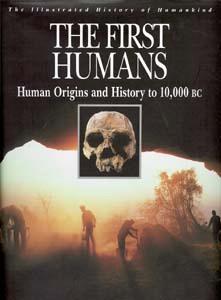

 |

|

The average rating for First Humans: Human Origins and History to 10,000 B.C. - Goran Hurst Thomas based on 2 reviews is 3.5 stars.
Review # 1 was written on 2018-01-16 00:00:00 Steven White Steven WhiteGood history for the most part. The frustrating thing about trying to see a history so far in the past is that our knowledge is subject to what survived, and what survived can only tell us so much. Much of what we 'know' about life in the past and our human origins is speculation based on very little physical evidence. The writers of this book acknowledged the controversies surrounding certain claims, and often would have opposing opinions both printed in their own segments. It is interesting to think about just how small our sliver of modern history is compared to how long humanoid life has been around. Thinking in such large terms is difficult, and it's hard to fathom change when the book gives you an estimate of how long that change took to occur in millions of years. From the book: "Tool making humans have existed on Earth for more than two million years. As a comparison, historic time comprises only some two or three thousand years-that is, about 0.2% of the time that humans have existed." I very much enjoyed all of the photographs, although some of the charts and graphs left a little to be desired in how readable they were. |
Review # 2 was written on 2012-12-05 00:00:00 Glenda Worthington Glenda WorthingtonI'm only halfway through, but I'm starting to have real issues. The First Humans ... is a lovely, large-format picture book -- great when you want a quick diversion. Flip through the pages and you will see great photos and eye candy layout. But look closer, and you'll soon discover some of the charts and maps could use better captions to explain what's being illustrated. And when you start reading, you'll soon run out of depth. Many interesting topics are introduced, but turn the page and it's off to some other topic. No subject is ever really developed and explored to a level which will satisfy a curious mind. It's really, more of a coffee table item than it is a book of knowledge. The way the book is organized can be irritating. Often subtopics of one or two pages are inserted right in the middle of a bigger topic -- it's not always obvious when you turn the page that you have been detoured to a subtopic, nor again, when the text returns to the main topic -- which by now, you've forgotten. But it's really some of the scholarship that I find to be the most objectionable. No attempt has been made to substantiate any of the claims made by the various authors -- no footnotes, references or bibliography. For example, after reading a dozen pages about numerous Clovis and Folsom sites in North America -- most of which are described as consisting of animal bones and a few projectile points -- chapter author George C. Frison makes these claims: "The mainstay of of the Paleoindian economy was hunting, which was a male-centered activity. Women butchered the meat from the kill, prepared it for consumption, and gathered plant foods. While the latter was a less prestigious activity than hunting, plants were an important part of the everyday food supply. Paleoindians lived in small bands, the only political leadership being provided by the male who claimed the greatest charisma by virtue of being the most accomplished hunter and provider ... In hunting societies like this, it was the women who moved to the husband's residence, since it was vitally important to survival that the intimate knowledge of the hunting territory be passed on from father to son." Aside from my objections to the author's misogynist attitude (with a side order of testosterone) -- how do you get all that from a few bones and stones? The author admits his conjecture is based on assumed parallels to recent hunter-gatherer societies, but I have little patience for such drivel when it is unsubstantiated by any actual evidence. Given the copyright date of 1993, I shouldn't be surprised that the Clovis-first chest-bangers like Frison get the main say. Research by Tom Dillehay and James Adovasio which supports pre-Clovis dates in the Americas is briefly mentioned, but treated as fringe because "... none has yielded ironclad proof acceptable to all archaeologists ... we have no unequivocal, indisputable archaeological evidence that the New World was inhabited before Clovis times." Considering archaeology is a field where any jackass in a safari vest can pick up a jaw fragment and tell you it proves the ancient man was bipedal, blue-eyed, and monogamous (but the master of his household) -- the pre-Clovis evidence is obviously being held to a much higher standard. At $10, you'll easily get your money's worth, but if you have more than just a casual interest in the subject of our pre-history, you'll want to seek out more substantial (and more recent) reference books. |
CAN'T FIND WHAT YOU'RE LOOKING FOR? CLICK HERE!!!